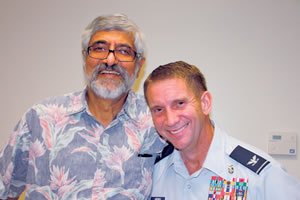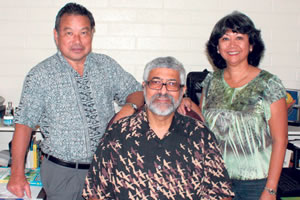Free Health Care? Yes, Sir!

Thanks to an innovative plan made possible by the U.S. military and state health department, Kaua'i residents will receive $1 million in free health care. Pictured (from left) is the team that made it happen: Toni Torres, Dennis Esaki, Dr. Dileep Bal and Col. Jerry Arends. Amanda C. Gregg photo
Kaua’i residents and the military both benefit from a creative program that will provide $1 million in free health care regardless of income level
Free health care for everyone on Kaua’i no strings.
When Kaua’i District Health officer Dileep Bal, M.D., M.S., M.P.H., who heads up the state Department of Health here, learned of this possibility, it seemed too good to be true.
“I said, ‘You’re kidding me,'” he says.
Luckily for Kaua’i residents, the doctor checked his skepticism at the door and instead pursued a project that will yield an estimated $1 million in free health care to Kaua’i residents early next year. Working with colleagues Thomas Noyes, Toni Torres, Rep. Dee Morikawa and Dennis Esaki to garner support and submit proposals to the Pentagon for both medical and engineering projects, a program dubbed “New Day Kaua’i” will be rolled out in February and March of 2012.
Bal says he learned of the opportunity 18 months ago, when Col. Jerry Arends briefed district health officers in Honolulu on the Innovative Readiness Training program, which brings in Army, Naval and Marine reserves doctors from around the globe to provide free health care to anyone who wants it.

Project coordinators met earlier this month to finalize plans for the free clinics
“Anyone” is the operative word,” Bal says, as the care is not income-based.
“Some 350 medical and support military personnel will be deployed to Kaua’i and will set up clinics where members of the public can see whatever type of medical experts they need: dentistry, optometry, internal medicine a very broad range offered at no cost. I thought to myself, ‘This is free money,'” Bal says.
Or, as it was explained at the brainstorming/briefing in early November, “You can drive up in a Mercedes and be seen for free by a doctor, no questions asked.”
A longtime champion for social justice, bringing a resource of this magnitude to Kaua’i is a somewhat poetic accomplishment for Bal, who has spent his entire career working to improve and augment health care for people rather than implement cutbacks.
“Our kuleana on Kaua’i is health care,” he says simply.
Originally from New Delhi, India, Bal attended the All India Institute of Medical Sciences before getting graduate degrees in public health from Columbia and Harvard universities.

Col. Jerry Arends, Dr. Dileep Bal and Dennis Esaki during a conference call with the governor’s office. Amanda C. Gregg photos
Though budgets are tight, if anyone can find a way to increase health care availability during an economic downturn, it’s Bal.
Aspecial adviser on cancer, chronic disease, tobacco use and nutrition, Bal has led initiatives for breast and cervical cancer screening programs and spent two decades as chief of the Cancer Control branch within the Department of Health Services. A leader in cancer prevention efforts with innovative ideas like the California tumor registry and Proposition 99 (tobacco tax), he also taught as a clinical professor at UCDavis Medical School and the University of Arizona Medical School before coming to Kaua’i six years ago.
A member of the advisory committee for the Centers for Disease Control, he also serves on the editorial board for the Institute of Medicine of the National Academy of Sciences. So it makes sense that if a light bulb were to go on over anybody’s head for a way to find free health care on Kaua’i, it would be his. (Though he shudders at the thought of taking any credit.)
“I’m an old man and I don’t need any attention,” Bal says. “It’s because of people like Col. Arends, Toni Torres, Dennis Esaki and Dee Morikawa and the active encouragement of Gov. Neil Abercrombie this is happening.”
Torres, who will coordinate the entire medical effort, has been working in the health care system since 1975. Calling it “humble beginnings” at the former St. Francis Hospital on Oahu, she has been a public health nurse since 1989. Originally from Molokai, she met her husband Dr. Mariano Torres, now an internist on the West side, when he was an operating room tech and medical student on Oahu. But the two almost never crossed paths, she says.

Dennis Esaki, Dough Haigh, Dr. Bal, Col. Arends and Thomas Noyes go over final plans
“My initial career path was in elementary education, but my UH counselor said I should go into nursing as there would be too many teachers when I graduated,” she says.
The couple moved to Kaua’i in 1985 because Mariano wanted to practice medicine in a rural setting. Torres says that heading up the medical effort of the New Day Kaua’i project will not only help local people on a large scale, but will allow her to do what she loves best: making an impact on the health and wellness of the community at large.
Torres has helped recruit community volunteers for the project, which has grown to include Community Partners Putting Prevention To Work, Kaua’i Economic Opportunity, Agency on Elderly Affairs, Department of Education, Wilcox Hospital, Kauai Hongwanji, The Salvation Army, Calvary Chapel of Hope, Kaua’i Lions, Kaua’i Ministries and Kaua’i Community College. Working alongside community volunteers means getting over a few small logistical hurdles, too, like finding the doctors a place to stay where they can simultaneously offer medical services. That’s a problem Rev. Ben Nelson, rector for All Saints Church of Kapa’a, helped solve, as he arranged for services to be held elsewhere so doctors can stay at the church.
The next hurdle will be ensuring that people come.

Dr. Bal and Col. Jerry Arends. Amanda C. Gregg photos
“We would rather have the clinic jammed up than have too few come,” says Bal. Emphasizing that the offerings aren’t only screenings or urgent care or for those without insurance, he says the kinds of medical attention some consider luxuries because of the high co-pay cost, like proper eyewear, also will be offered.
“Even with the amount some of my own staff make, they can’t afford new spectacles,” Bal says.
Lenscrafting will be available, too, so people who want glasses can get them right away.
The project also will help the military. As Arends points out, it is a “winwin” because of the onsite experience it gives medical professionals who are in the reserves.
Though Arends describes the program as “training,” he’s quick to elaborate: The doctors brought in are already trained in medicine. In fact, he notes, many have their own flourishing private practices, but are committed to completing two weeks’ site training every year. The training aspect is so they can practice treating patients in a makeshift atmosphere, enabling them to be better prepared to do so in military situations where they’re called out to treat people in areas that have been affected by natural disasters or wartime emergencies.
“These are medical professionals. But it helps train them in readiness to deploy close up shop and quickly go someplace and contribute to the response effort and set up a medical operation,” he says. “The benefit to us also is it’s much more helpful to go somewhere and do something good than going to your base and providing exams to mannequins or colleagues. And it helps keep medical professionals in the military, which is a difficult thing.” Cultural training and exposure are added benefits, Arends says, adding that hands-on experience in learning and respecting a different culture is key in U.S. diplomacy.

Dr. Bal with Dennis Esaki and Toni Torres
“A cultural briefing will be given to all reservists participating, Torres says. “I’m even thinking about a Pidgin 101.”
Bal says the plan for the Kaua’i program will be done over the course of five years, starting in 2012 with a two-week effort that will increase to four weeks in 2013. Beyond that there are plans for a civil engineering effort that will bring in reservists who aren’t doctors, but who can offer free labor to augment infrastructure needs. After learning of the civil engineering possibilities, Bal and Noyes approached county engineer Larry Dill and Building Division chief Doug Haigh about its potential. Haigh says the plan is to use part of the free labor for connectivity from Kawaihau Road to Ke Ala Hele Makalae (the multiuse path) so students can cross the street for science projects and get to the athletic pool more safely, along with utilizing labor for Habitat for Humanity efforts in ‘Ele’ele.
As for what Bal gets out of all of this, in addition to getting to see his passion for social justice come to fruition from all those he hopes will show up for free health care in early 2012, is the mere satisfaction of making a difference.
That, and perhaps enjoying a future early evening stroll with his wife Muktha on Ke Ala Hele Makalae and getting a glimpse of some keiki safely crossing the busy street to get there.



